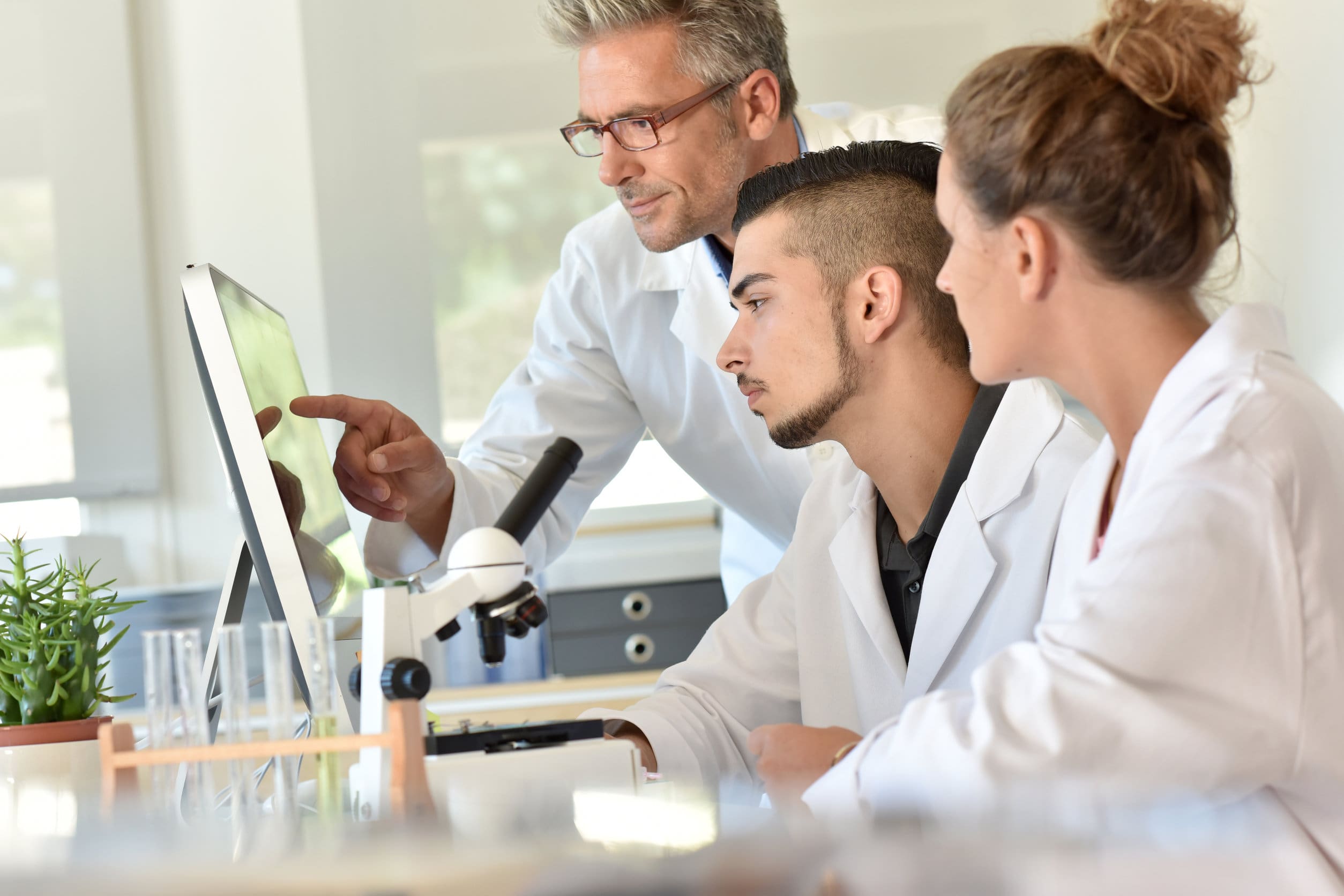Glycolysis is the first step of cellular respiration that occurs in the cytoplasm of the cell. It is the stage of the breaking up of glucose’s six carbon rings into two three-carbon molecules known as pyruvic acids (sometimes referred to as pyruvates).
To put simply, glucose has a carbon backbone; six carbon atoms bonded to hydrogen and oxygen. The process of glycolysis breaks this carbon backbone in two:
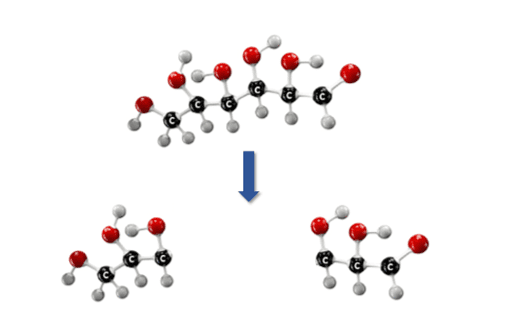
Each of the carbon backbone molecules are known as pyruvic acids, or pyruvates. So, glycolysis is effectively the breaking up of glucose into two sets of three pyruvic acid molecules.
The process of glycolysis requires two ATPs in order to work. However, in carrying out the process, four ATPs are created – meaning that the process of glycolysis generates the net amount of two ATPs. Oxygen is not needed for this process to be carried out, which means it is an anaerobic process – this is the anaerobic part of respiration (in the absence of oxygen altogether, the pyruvates formed through glycolysis get rerouted into a process known as fermentation rather than going onto the Krebs cycle – we will discuss the process of fermentation in much more detail in a later chapter).
Glycolysis does not just produce ATP; this process is also taking two enzymes known as NAD+ and adding two hydrogens and two electrons to them to form two NADH compounds – each NADH contains a high amount of energy.
The sets of pyruvic acids that have been generated in the process of glycolysis then enter what is known as the Krebs cycle (sometimes referred to as the citric acid cycle) as long as there is oxygen present. The Krebs cycle is an aerobic process, which means it requires oxygen to be around in order to work. This process takes place in the matrix of the mitochondria. Mitochondria membranes have inner folds which increase their surface area. Take a look at the diagram of a mitochondrion below.
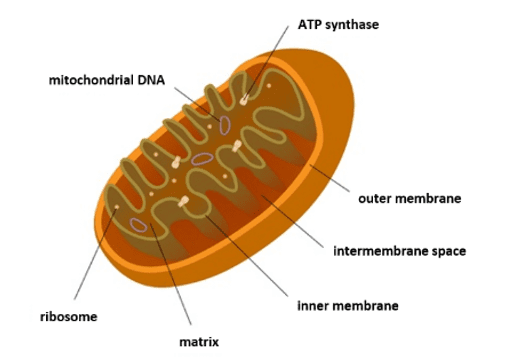
ATP synthase is an important enzyme that helps create ATP (the energy storage molecule).
In the Krebs cycle, the mitochondria take the products of glycolysis (pyruvic acids) and rework them to create another two ATPs per glucose (plus more NADH compounds from NAD+). Everything that happens in the Krebs cycle is an enzyme catalysed reaction.
The oxidation of the pyruvic acids is a step that is sometimes referred to as being the first in the Krebs cycle, however, it is really a preparation step that happens after the process of glycolysis but before the Krebs cycle. The oxidation of pyruvic acids happens when one of the backbone carbons is taken away, so it is left as a two-carbon compound. The backbone two-carbon compounds are known as acetyl-CoA (acetyl coenzyme A). During this step, NAD+ is also reduced to more NADH (when we talk about reduction we refer to something gaining an electron).
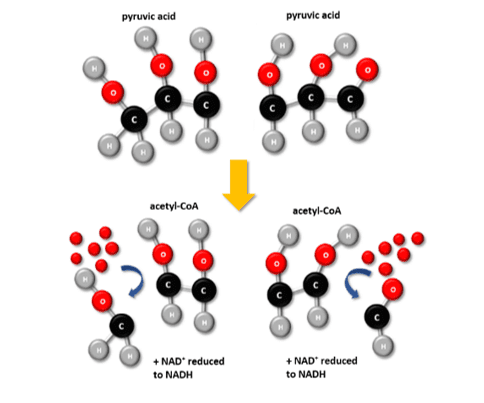
Acetyl-CoA is formed when the Krebs cycle technically begins. After its formation, enzymes react with the acetyl-CoA causing it to form with a four-carbon compound molecule of oxaloacetic acid – creating a six-carbon compound molecule known as citric acid, or citrate.
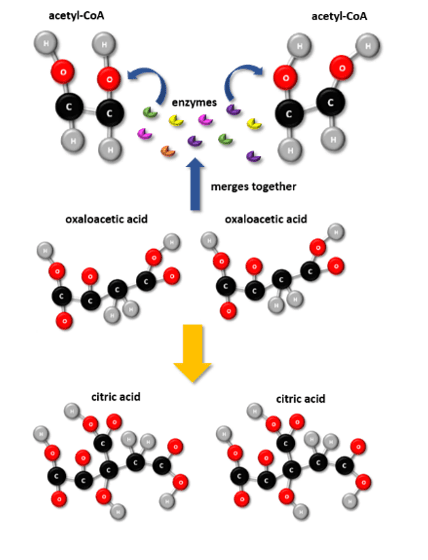
The citric acid is then oxidised over a number of stages in the Krebs cycle which, overall, separates two carbons from it to get it back to oxaloacetic acid (when carbons are broken off molecules, oxygen gets added to it and it forms CO2 (carbon dioxide) which is then ejected by the body as a waste product). When enzymes remove carbon and hydrogen/electrons, intermediate molecules are able to be formed, e.g. α-ketoglutaric acid, succinic acid and malic acid. Dehydrogenase enzymes then act to remove hydrogen ions and electrons from these intermediates. These hydrogen ions and electrons are then passed to coenzymes NAD+ and FAD to create NADH and FADH2. Look at the below diagram which illustrates the individual steps and products of the Krebs cycle.
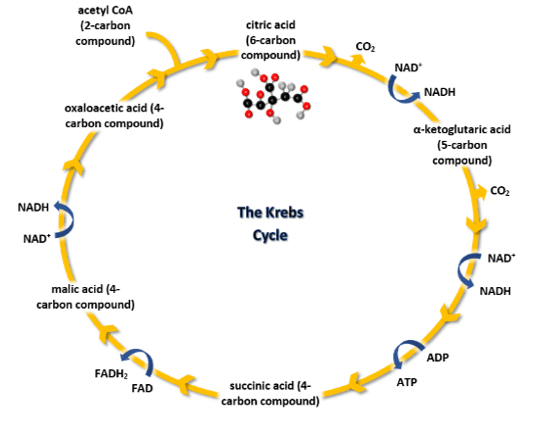
The whole cycle is to generate NADHs, FADH2s and ATPs. NADHs and FADH2s are the inputs into the electron transport chain (where the majority of the energy during respiration is produced – we will discuss this more shortly).
The Krebs cycle occurs for each molecule of citric acid, so in this case, the Krebs cycle occurs twice per one molecule of glucose.
During glycolysis and the Krebs cycle we are constantly taking NAD+ and we are adding hydrogens to it to form NADH. During glycolysis and two turns of the Krebs cycle, in one molecule of glucose ten NAD+s become NADHs – these drive the electron transport chain to produce more ATP molecules.
The electron transport chain produces the majority of the ATPs during respiration – 34, to be exact. This is also an aerobic process, meaning that it requires oxygen in order to work. This stage is a collection of proteins that are found on the inner membrane of a mitochondrion. Electrons are required in order for the transport chain to work; therefore, NADH and FADH2 release these electrons.
Electrons transfer energy to the proteins in the membrane. This provides the energy that is required for the pumping of hydrogen ions across a membrane.
ATP synthase is an important enzyme that helps create ATP. The movement of ions across the membrane during the electron transport chain helps to synthesise ATP by ATP synthase.
Each NADH going into the electron transport chain will be indirectly responsible for the production of three ATPs and each FADH2 will be indirectly responsible for the production of two ATPs (the reason it produces less than NADH is because the electrons of FADH2 are at a slightly low energy level).
Finally, oxygen combines with hydrogen to form water. If no oxygen is present, then this results in hydrogen being unable to pass through the electron transport chain which causes a reduction of ATP molecules being produced.
Take a look at the following diagram which details the process of the electron transport chain.
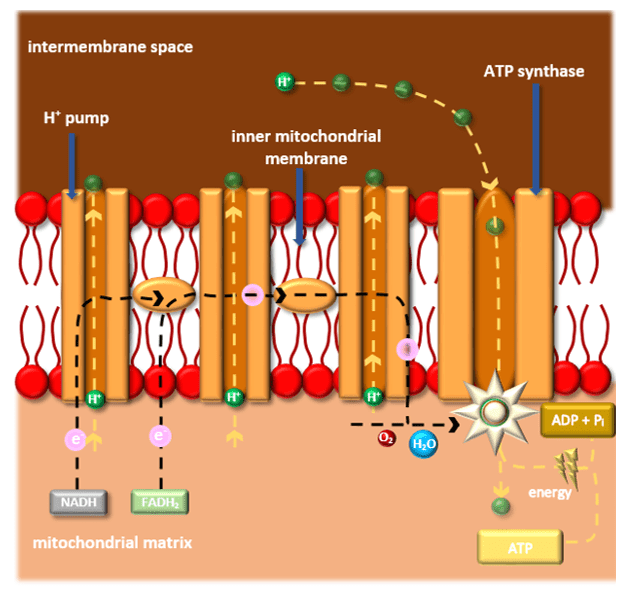
So, from only one molecule of glucose we have a total of 38 ATP molecules. We will briefly go over the steps taken to reach this number of ATP molecules.
During the process of glycolysis, two ATP molecules (net) and two NADHs were produced.
During the preparation stage before the Krebs cycle, the oxidation of the pyruvic acids created one NADH each: making two NADHs.
During the Krebs cycle, we get three NADHs for each pyruvate going in: making six NADHs. One ATP is also produced per turn of the cycle: making two ATPs. One FADH2 is produced per turn of the cycle: making two FADH2s.
Every NADH going into the electron transport chain produces three ATPs. So, the ten NADHs that have been produced in the stages of glycolysis and the Krebs cycle are going to produce 30 ATPs in the electron transport chain.
Each FADH2 going into the electron transport chain gets oxidised and produces a further two ATPs – so two of them are going to produce four ATPs. When adding up the number of ATPs throughout the three stages this gets us to the 38 ATPs that are expected in a super-efficient cell when reacting with one molecule of glucose.
Although most food ends up as glucose, starch, glycogen, proteins and lipids can be used via alternative metabolic pathways. These molecules can be converted into a number of intermediates of glycolysis and the Krebs cycle. This allows them to join the cellular respiration pathway at different intervals. For example, lipids can be broken down into two different components: fatty acids and glycerol. Glycerol can be converted into an intermediate of glycolysis which then allows it to continue down the respiration pathway e.g. the Krebs cycle and the electron transport chain.
For the exam, you will need to know the word equation and the chemical equation for aerobic respiration in living organisms:


Plants respire during both the day and the night. In some instances, a lack of oxygen will occur causing the plant to undergo anaerobic respiration – we will discuss this in the next chapter.

